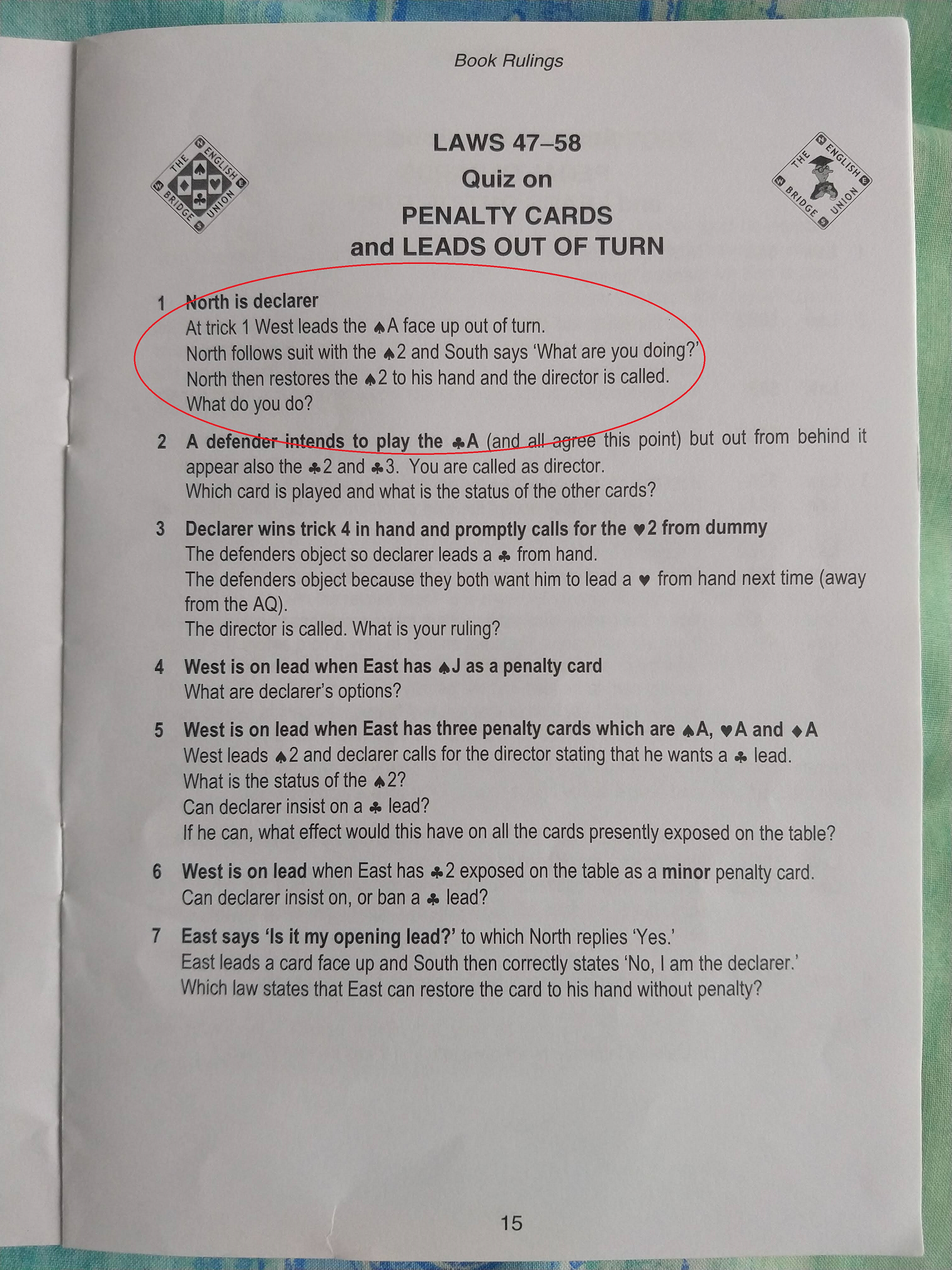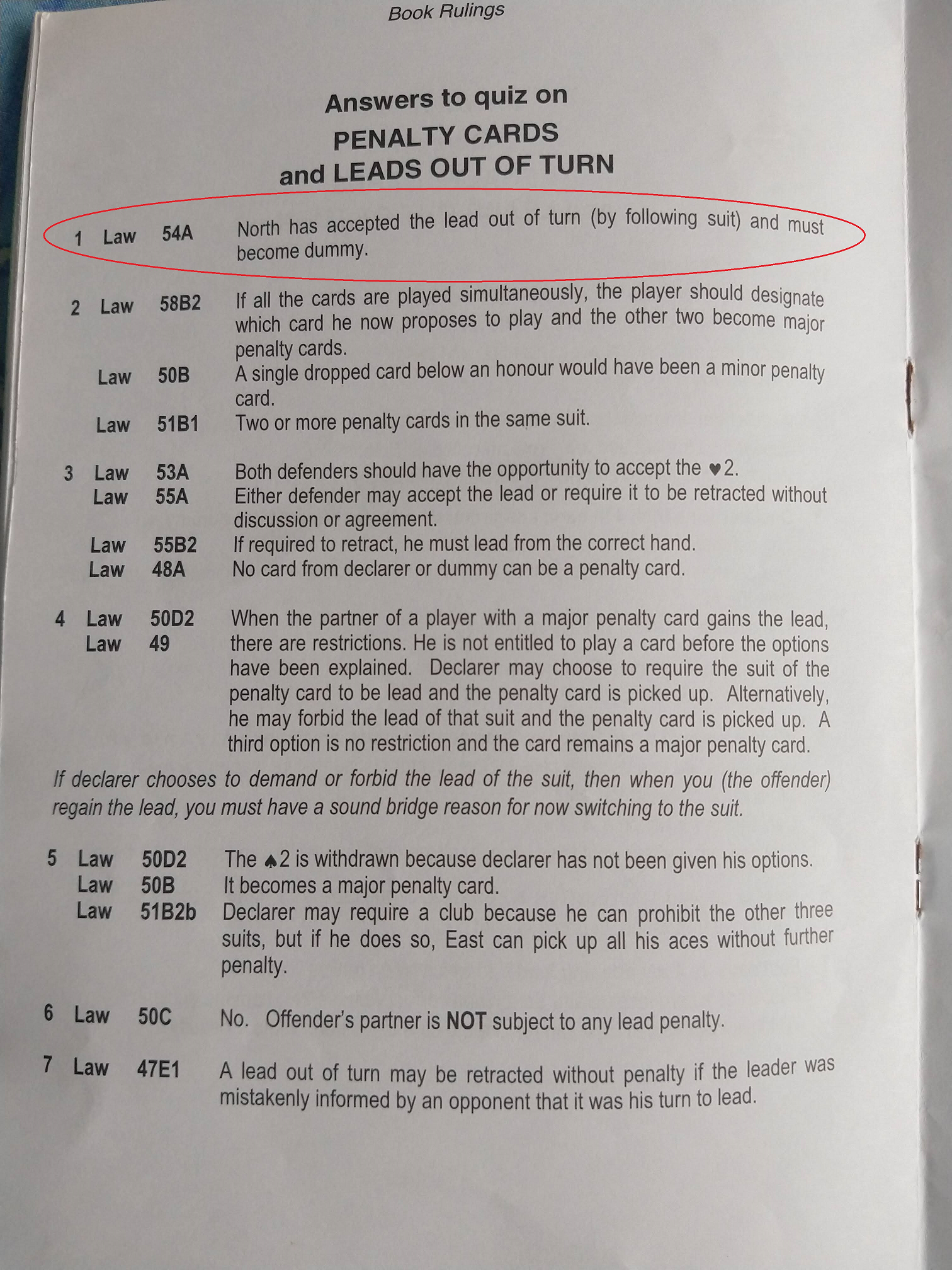Faced opening lead out of turn
North is declarer.
At trick 1 West leads the SA face up out of turn.
North follows suit with the S4
According to Law 53A, N has accepted the lead.
Does N still have the choice (Law 54) as to whether he is declarer or dummy?
An argument against him being allowed to become dummy is that he has already made a decision as to which card to play.
This gets more intriguing. In a course book I have from the Cub Director's course I attended, it states that N MUST become dummy. Ok this was under the 2007 laws but these were identical. Where does this come from?

Comments
Law 54A
"A. Declarer Spreads His Hand
After a faced opening lead out of turn, declarer may spread
his hand; he becomes dummy. If declarer begins to spread
his hand, and in doing so exposes one or more cards, he must
spread his entire hand. Dummy becomes declarer. "
Looks like the "declarer" exposed one card by following suit with the S4 before the director was called. Therefore they are no longer "Declarer" but "dummy". But I am confused because you mention Law 54, so can only assume you have a different interpretation?
Not sure about the laws for 2007 but can only assume they had the same or similar wording.
CMOT
I question whether playing (exposing) a single card amounts to spreading a hand.
The law says " If declarer begins to spread his hand, and in doing so exposes one or more cards", not " If declarer exposes one or more cards he is deemed to have begun to spread his hand".
Yep
See where you are coming from. I suppose it depends on whether it can be said that laying down and exposing one card can be the start ( or begins as shown in the law) of spreading the hand or not.
There again if you take into account Law 60 A 1 & 2 it would appear that the right to rectification has been forfeited and the illegal play is treated as if it was in turn. So if that were the case then I think the original "declarer" becomes dummy. The non offending side can't "invoke" Law 54 and have the choice. The only exception mentioned in Law 60 A 2 is 53B.
CMOT
Agreed - 60A1 clearly states that the right to rectification has been forfeited. So NOS cannot invoke law 54A.
But it is law 54A that gives declarer the "right" to become dummy (and therefore the automatic "must" if he so actions).
Yes the play is deemed to be in turn. but that only means that the next player to play is (presumed) declarer, not that declarer must become dummy.
If playing a card forced declarer to become dummy, then we would have both laws 60A1 and 54A specifying what happens, and determining different outcomes.
To my mind, there is no contradiction. if declarer plays a card, law 60A1 applies. If declarer spreads his hand, law 54A applies. If he does both, director will have to determine which happened first.
If the spreading happened first, law 54A applies and dummy has suggested a play and law 45F comes into play.
If the play happens first, then law 60A1 applies, and declarer has just exposed some or all of his cards, so law 48A applies.
The law is not clearly laid out in terms of what takes precedence, though.
Jeremy
This reminds me of an incident at the first tournament I ever played in – I was presumed declarer on the first board, and after the opening lead (in-turn), my (pickup) partner played a card rather than spreading their hand and becoming dummy. I'm actually not sure what the relevant Law for fixing this is (although it seems to fit the letter of 45D1; oddly, 45F seems not to apply, even though dummy has suggested a play). In the incident discussed in this thread, if declarer is to become dummy, then effectively the same thing happened – this is probably enough reason for disallowing declarer from becoming dummy unless they were clearly attempting to spread their hand and just happened to play one card first.
(It was a strange board – my partner had made an insufficient bid at their first opportunity to call, replaced it with an incomparable pass, and the contract was passed out from there. So my partner's first non-irregular action wasn't until the second board of the session.)
How about law 41. If the lead is condoned by the presumed declarer and is treated as in law 60 A 2
"Once the right to rectification has been forfeited, the illegal play is treated as though it were in turn". So now we go to Law 41 and the presumed declarer is to the right of the condoned lead. Or am I reading too much into this?
Now we can say that, in your case, the S4 hasn't been played as it hasn't been designated by the declarer and 45 D applies.
CMOT
I think the situation is clear. If the director determines that the presumed declarer did indeed play to the first trick and was not trying to put down his hand as dummy then 54B1 applies and although dummy should have been faced before this play it certainly must be before the next defender plays.
(Presumed) Declarer is not determined by who ends up leading to the first trick, but by the definition: "the player who, for the side that makes the final bid, first bid the denomination named in the final bid. He becomes declarer when the opening lead is faced". This only gets overridden by 54A, where declarer spreads his hand.
I agree with Paul here, I think we've been overthinking it a bit. If declarer is considered to be playing to the trick then that's what they've done, and they can be considered to have opted for partner to be dummy. If declarer was starting to spread their hand (I guess this might not be straightforward to determine, but will usually be evident) , then they're putting dummy down.
If you determine the latter the card in question hasn't been played, the wording used in the original post implies it was a played card.
Yep can see what Paul means about 54B. It does refer to Law 53
Law 53A it says "It becomes a correct lead if declarer or either defender, as the case may be, accepts it by making a statement to that effect, or if a play is made from the hand next in rotation to the irregular lead (but see B)."
However, that doesn't explain the final paragraph from the OP
"This gets more intriguing. In a course book I have from the Cub Director's course I attended, it states that N MUST become dummy. Ok this was under the 2007 laws but these were identical. Where does this come from? "
In my course books (2017) this was not covered (or I can't see it). So why particularly mentioned in the 2007 course but not in the 2017 course? On most occassions in my course books they refer to a Law for any "action" so I am surprised that Jeremy's course book does not make a reference for this.
CMOT
I suspect there have been many versions of the course books, some under the 2007 laws (and no doubt earlier), some under the 2017 laws.
I went to try to find out the date of my course and it appears to have been in 2003, thus on the 2000 laws! Again though, these do not differ from the 2017 laws in the relevant laws.
If you're interested in looking further, these are relevant pages from my course book:


Yes very odd, there is no reference to 54B
I also note that the Booklet "Bridge Rules Simplified" by David Stevenson talks about "condoning the opening lead" refering to "spreading the hand" or by dummy also spreading their hand but nothing about presumed declarer playing to the trick. So why call it "condoning" but not mentioning Law 60.
It is almost as if they are reading the law not as "If declarer begins to spread his hand, and in doing so exposes one or more cards, he must spread his entire hand." but as "If declarer begins to spread his hand, OR exposes one or more cards, he must spread his entire hand.".
Just checked with Jacob Duschek (page160 3rd para) Doh! should have looked there first. and Paul is dead on.
CMOT
P.S. unlikely to come across this problem in normal play (I sincerely hope) but given Paul's response I know which way I will jump if it does turn up...........unless someone know different. Thanks Jeremy interesting subject.
There were no 2000 laws.
No, there are 1997 laws, which were updated (tweaked) in 2000 (released 2001) to cope with online bridge.
Not so. The WBF Code of Laws for Electronic Bridge 2001 was separate to the 1997 Laws, not a replacement for them. I re-iterate, there were no 2000 laws.
This takes me back a bit!
It is a long time since I last saw mention of the WBF Code of Laws for Electronic Bridge 2001. I remember being invited to comment on the draft back in 2000 as CTD for the EBU Online Bridge Club (that later became BCL). This was when online bridge was still just getting off the ground.
It was widely expected that the WBF Laws Committee would update the Online laws after the 2007 Laws were published, but this never happened, and the 2001 Online Laws became generally forgotten.
Nowadays it seems quite sufficient for online bridge to follow the WBF 2017 Laws and "local" regulations for respective platforms, such as the EBU Sky Blue Book (covering EBU games in Real Bridge and BBO). BCL has its own very similar regulations.
Barrie Partridge - CTD for Bridge Club Live